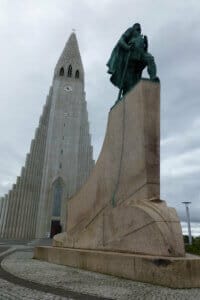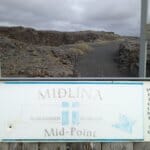It’s one of the hottest destinations of the past couple of years. From whale watching to the Northern Lights; natural wonders to a surprising amount of craft beer, Iceland seems to have it all but is it possible to do Iceland justice in just 48 hours?
48 Hours in Reykjavik: Getting There
With low cost Icelandic airline Wow Air making big inroads in Europe and America, via its base at Reykjavik, it’s never been cheaper to get to Iceland than now, so if you have a weekend to spare what exactly can you do in the land of unpronounceable names?
First things first, let’s get the shocking bit over; Iceland is not a cheap destination. Your flight and accommodation may be cheaper than they have ever been but don’t expect that to extend to the costs of living and sightseeing.
Eating out and enjoying the odd drink are, comparatively speaking to anyone that doesn’t live in Scandinavia, extortionately expensive. It would be a brave (or very rich) bride and/or groom that would decide on Iceland as a stag or hen party destination but that didn’t stop a small group of lads enjoying the delights of the Blue Lagoon on my visit there. They had to pay an almost 4 figure sum for the drink before exiting with their wallets a lot lighter. Making the groom wear a lime green mankini in the bright blue turquoise waters of the lagoon was an inspired choice and good on them for picking something out of the ordinary to celebrate.
There are 2 ways to do Iceland. A city tour staying in Reykjavik or you can see the country either on an organised tour or drive yourself using the ring road (Route 1) that encircles the place taking in many of the island’s top sights in its 832 mile (1339km) route. It’s very difficult to get lost; signs are in both Icelandic and English. As a general rule driving limits are 30-30km/hr in built up areas, 80km/hr on gravel roads and 90km/hr on paved roads (which is the bulk of Route 1). Off road driving is illegal and there is a free app you can download to make it easier for the emergency services to find you should something happen when you’re driving (or hiking).
For the purposes of this post, a weekend isn’t nearly enough time to see the full country so today we’ll concentrate on staying in Reykjavik. All flights land about 50 kilometres outside of the city at Keflavik International Airport. Driving through the Reykjanes Peninsular on your way to Reykjavik you will pass one of the most popular stop offs, the Blue Lagoon. To save making a special trip plan to visit either on your way into Reykjavik or as you head back past on the way home. If you’re not driving you can pick a transfer that will stop off at the Blue Lagoon for a couple of hours giving you a chance to sample what it has to offer.
48 Hours in Reykjavik: Reykjavik Highlights
The capital city of Reykjavik itself is a charming port city. The centre point and tallest building is the Hallgrímskirkja Church in the heart of town. If you get lost wandering the colourful neighbourhoods it’s easy to find your way back again. While you’re there you can get a great panoramic ariel view of the city from the bell tower of the church.
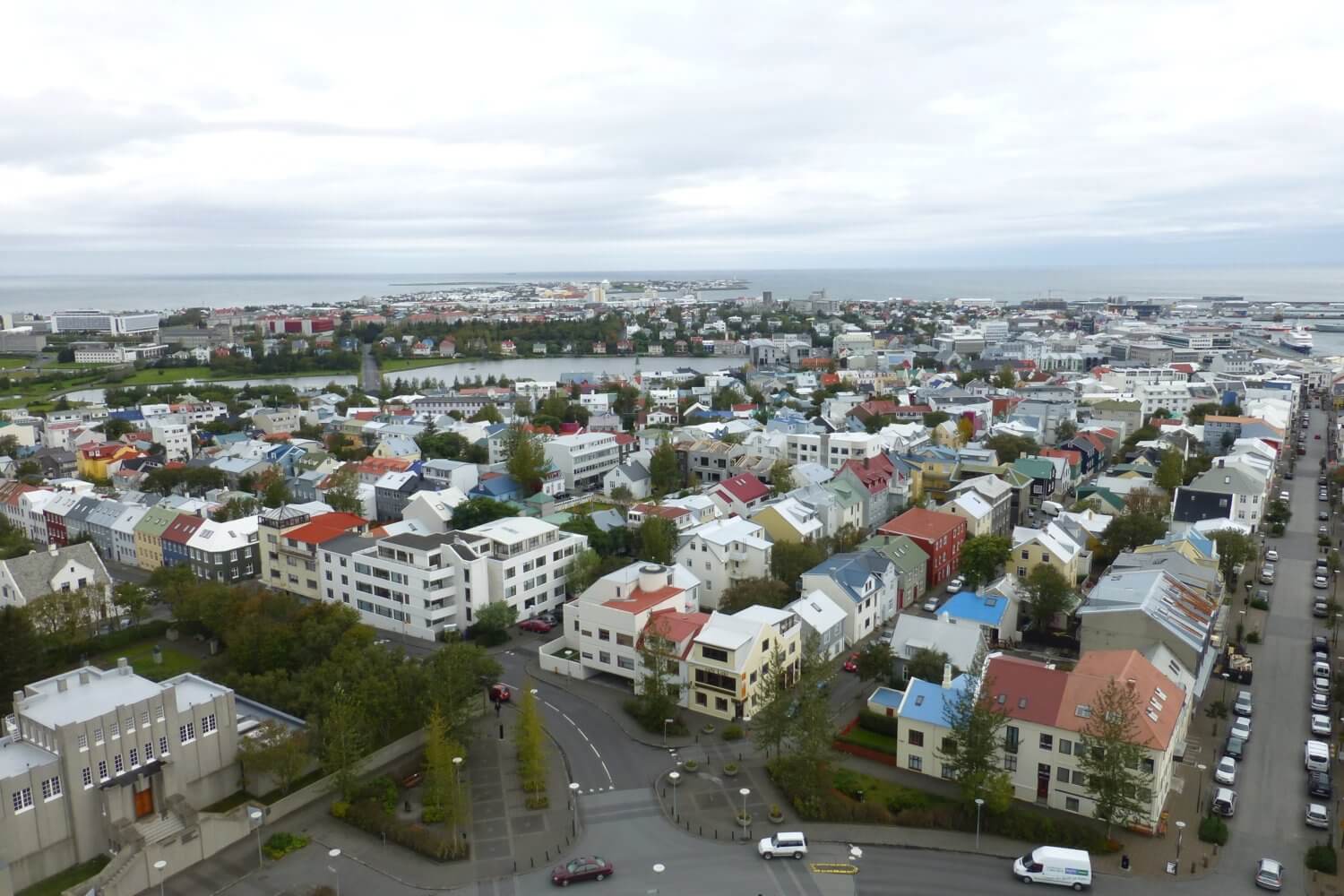
The stunning view over the Old Harbour and Hljómskálagarður Park and lake from the 73 meter tall bell tower of Hallgrimskirkja Cathedral.
Shopping isn’t cheap here either but you will find a large array of adventure clothing shops, given the destination that isn’t too surprising, but you will also find bookshops and street side cafes, as well as high end fashion and jewellery stores. All the stores are open quite late tapping into the predominantly tourist market who are out of town in the day seeing the plentiful sights.
48 Hours In Reykjavik: Eating Out In Reykjavik
You are spoilt for choice on where you can eat out. Iceland is known for its great seafood and what better way to test that than on some traditional fish and chips. Icelandic Fish and Chips is a family run establishment just outside the main shopping street right on the harbour front.
My wolf fish and traditional chips washed down with a hand pressed lemonade is without a doubt the most expensive fish and chips of my life but also the best tasting so far.
Reykjavik Roasters is hands down the best coffee in the country and just round the corner from Hallgrímskirkja Church making it an ideal stop off before more sightseeing in town.
48 Hours in Reykjavik: Reykjavik Nightlife
You would think that with things being so expensive restaurants and bars would struggle to survive but Reykjavik has a thriving nightlife thanks to some of the quirkiest bars you are likely to come across.
If you would like to make the most of your time in town and sample some of the local cuisine here’s my pick of the top places to see on your stay.
- Micro Bar – The place for beer in Reykjavik. There is one menu for bar snacks and a thicker one for the amount of beers available! My favourite hangout in town.
- Kaldi Bar – A great place to start the night off by trying one of the local brewed kale beers.
- Kex Hostel – Thanks to the lucky timing (for this bar at least), of the 2008 Icelandic financial crash, the trendy bar within this hostel hostel in an abandoned biscuit factory owes its fortunes to the developers failing to gain enough cash to flatten the factory and build some high price skyscrapers in its place. You could also get a room for the evening in the heart of town.
- Kaffibarinn – Coffee Shop by day and bar by night, this Reykjavik staple is known for its friendly atmosphere and great DJs.
- Boston – If you’re after a more romantic evening the wooden decor of the Mexican inspired menu of this restaurant could be your ideal date night stop off.
What’s With The Smelly Hot Water?
One thing you will have to get used to while in town is the hot water thats used everywhere. Unlike the rest of us, Icelanders have no need to heat cold water to bathe in. The earths crust is so thin here they can tap directly into the geothermal activity taking place beneath their feet and all hot water in the country comes courtesy of the Mantle underneath your feet. That does mean you will have to get used to the “rotten egg” smell of sulphur when showering. Locals don’t even notice it and after a few days neither will you, but on a long weekend your olfactory nerves will be a little sensitive to it.
48 Hours In Reykjavik: Local Sights
With only 2 or possibly 3 days on a long weekend you will want to keep your sightseeing activities local. Iceland may look small on a map but it is surprisingly large with few shortcuts thanks to the massive Vatnajökull Glacier at its heart.
Thankfully the Reykjanes peninsular and surrounding area has plenty of sights to keep you busy for the weekend and even longer if you decide to extend your stay.
The Golden Circle Tour
Its one of the most popular day tours from Reykjavik and for good reason. In the roughly 300km long tour you can take in 3 of the country’s most popular contrasting sights:
Þingvellir (Thingvellir) National Park
It’s literal translation is “Parliament Plains”. You may know Þingvellir better today as the barren yet beautiful setting for North Of The Seven Kingdoms in season 4 of the uber popular Game Of Thrones Series.
In reality, as its name suggests, Þingvellir is the site of the first national parliament set up in 930 and ran over 800 years until 1798.
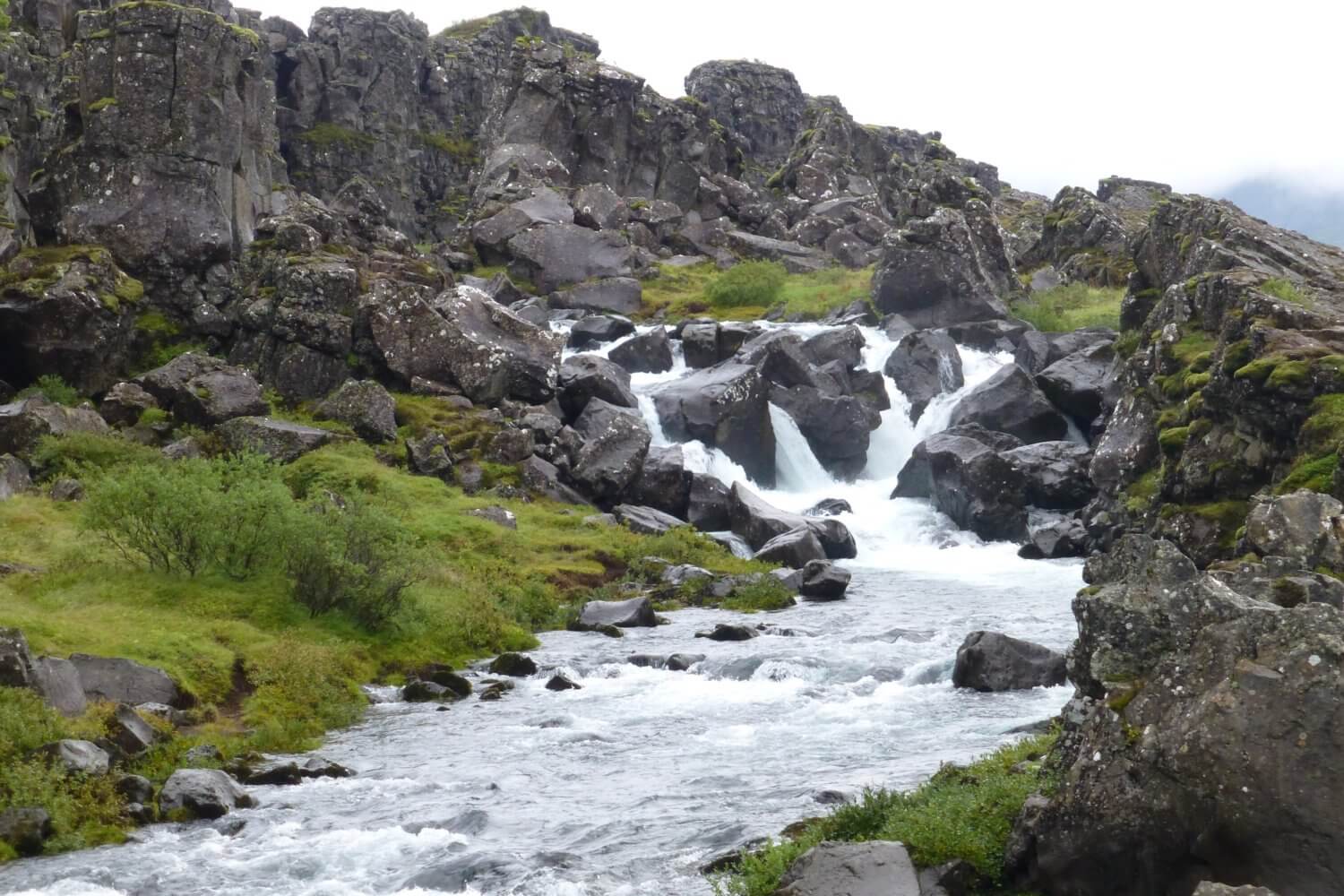
The beautiful yet artificially created 20 meter tall Öxarárfoss Waterfall is at the far end of the Almannagjá Fault.
You can comfortably walk through the site in 40 minutes from the dramatic entrance of Almannagja Canyon where the earths crust is separating, along the plains that stretch out 7km at another fault called Heiðargjá. You will want to take a little more time time here though. The place is simply stunning.

Looking down on the deep crystal clear water of the Silfra Rift where you can dive between two tectonic plates.
Gullfoss Waterfall
Located on the Hvítá River the thundering Gullfoss (Golden in English) Waterfall is fed by Iceland’s 2nd largest glacier, Langjökull.

The thundering water of Gullfoss can be heard from the car park before the falls themselves come into view.
Water cascades a total of 32 meters in 2 stages into a canyon over 70 meters deep and 2.5km long. On sunny days permanent rainbows colour the sky and even on a cloudy day standing next to the falls makes for a memorable experience.
Entrance is free and the car park is connected to the waterfall by a boardwalk.
Geysir

The one that started them all. Geysir today is very erratic. People come to see its smaller neighbour Strokkur.
The geothermal field of Haukadalur where one of Iceland’s most popular natural phenomena sits is at the northern edge of of an area known as the southern lowlands. Given Geysir’s international notoriety its strange that Iceland’s most well know geyser sits just off the edge of a road.
Geysir itself today is very erratic, it is it’s close but smaller, neighbour Strokkur that people come to see. It is the most energetic spring in Iceland you generally only have to wait 10-15 minutes to see an eruption. The height varies but it’s usually 10-20 meters high. Still a very impressive sight.
Crossing the road and following the well marked trail you pass hot springs and small steam vents. The smell of sulphur permeates the air. You know you are in an area of extreme geothermal activity.
See The Reykjanes Peninsular
Heading in the opposite direction to the Golden Circle, a tour or drive through the Reykjanes Peninsular will take you through vast lava fields on your way to Seltún, a geothermal hotspot just off highway 42.

Looking down on the geothermal field of Seltun. Sulphur permeates the air and the hike to the top is a lung burster but gives great views over the area.
Driving towards it you can’t help but notice white hot steam shooting up into the sky. The, now familiar, smell of sulphur is so strong you can taste it as you make your way along boardwalks above bubbling mud pools and lots of steam vents.
Entrance is, again, free and the area is surprisingly large. Climbing the trail gives a great panoramic view of the surrounding area if you don’t mind getting your heart pumping.
Not too long before you stop at Seltún, park up and admire the views over Lake Kleifarvatn, the largest lake in the Reykjanes Peninsular.
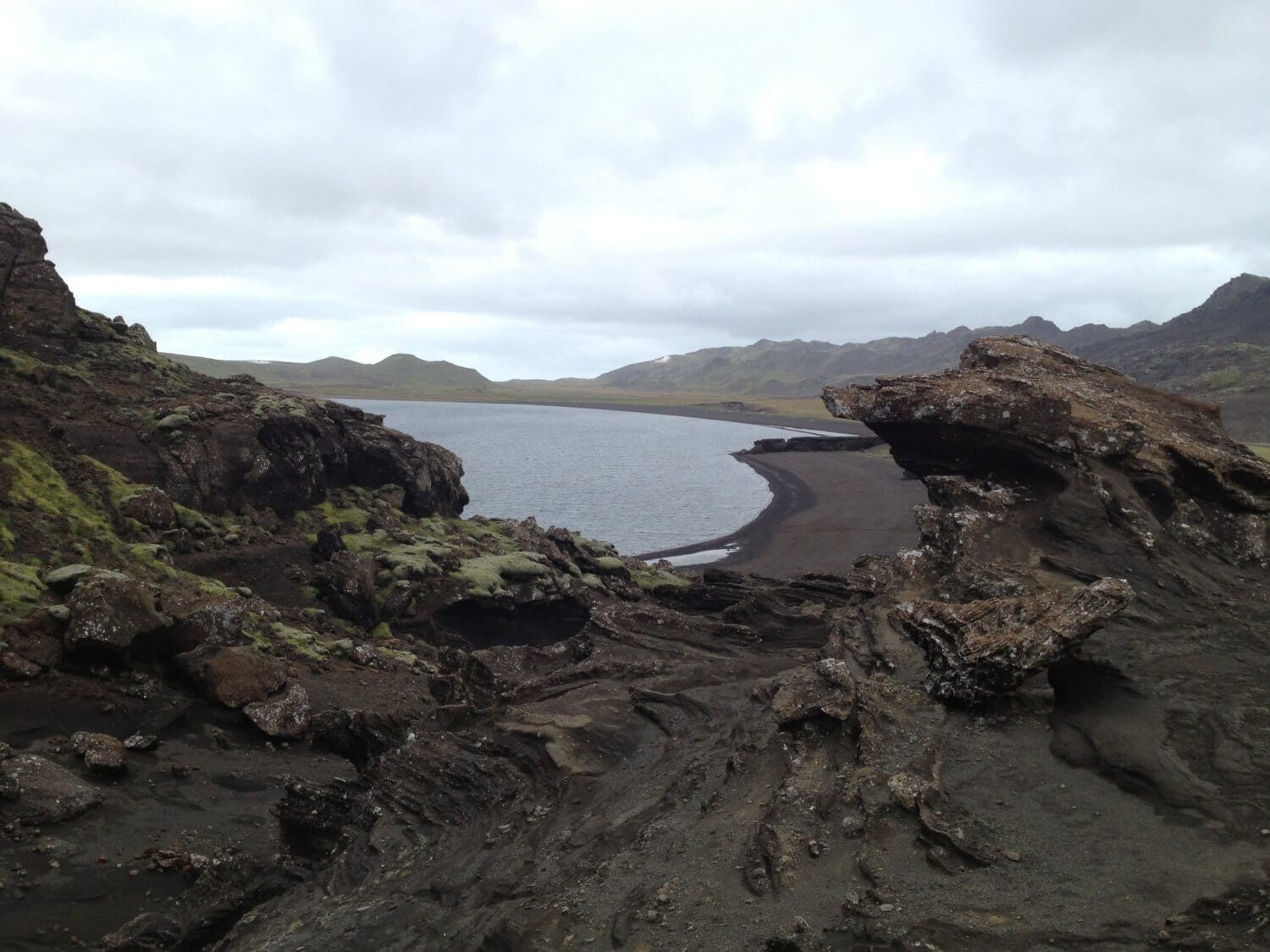
Still the largest lake in the Reykjanes Peninsular even though Lake Kleifarvatn has lost 20% of its surface area since a series of earthquakes struck Iceland in 2000.
Try to spot a river inlet that feeds the lake. You won’t find one. The lake is formed entirely from groundwater and is also incredibly deep (97 meters, 318 ft at its deepest section).
Local folklore says that a monster lurks in the depths making Lake Kleifarvatn Icelands own Lock Ness.
Pulling up at an unassuming car park it’s hard to make out who exactly is close by. Following the trickle of tourists the focus of the last stop in the Reykjanes Peninsular is a record breaking bridge, the Leifur Eiriksson Bridge.
How long would you say it takes to get to America from Europe? 5 Hours from London to New York normally. Here you can do it in 60 seconds.
Or, more precisely, you can walk from the Eurasian Plate to the North American Plate across the 20 meter long bridge named after Icelands most famous explorer.
Iceland is the only place on the planet that you can walk across the Mid Atlantic Ridge, the giant scar that runs north to south on the ocean floor. Most of the time it is buried thousands of feet below the surface of the Atlantic Ocean but here it is exposed to the cold Icelandic wind. Its a somewhat surreal thought when you are deep in the valley under the bridge looking up at the towering continents either side.
It reminds you how small and insignificant we can be on a universal scale.
Blue Lagoon
You’ve had a hard couple of days sightseeing in southern Iceland. What better way to relax before your flight than soaking in the natural waters of the Blue Lagoon.
It is probably the most well known of Icelands man made attractions but few people realise that you are swimming in is geothermal power station run off.
The Blue Lagoon is actually a mistake. It was never supposed to exist. You’ve got to give it to the Icelandic people for turning what is effectively a waste product into one of the most visited attractions in the country.
The silica rich turquoise blue waters do wonders for your skin and Blue Lagoon products sell for a pretty penny in the gift shop at the exit. Mud never smelt so good!
Come mid 2017 the Lagoon will have undergone another expansion, the first since its relocation in 1999, and now covers 8700 square meters containing 9 million gallons of mineral rich water. You can even overnight here before your flight home in the 60 room luxury hotel.
National Geographic even named it as one of the to 25 places to visit in a special edition of its magazine in 2012. Once you step into the warm blue waters you’ll instantly realise why.
So, what is it that Iceland has got exactly? The answer is it has got everything. Rugged glacial landscapes, an unpronounceable language, welcoming people, fantastic food and drink, natural wonders and history in spades. People flock here for a chance to see humpback whales or the Northern Lights but once you arrive you will realise that there is so much more to this fantastic island.
48 hours is a great introduction to this wonderful country of extreme contrasts but it is just an introduction. Once you make it here you will discover you’ve only just scratched the surface of what you can do.
Isn’t it time you discovered Iceland?
 Copyright secured by Digiprove © 2017
Copyright secured by Digiprove © 2017

